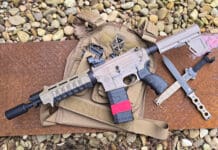[HTML1]
It was a more innocent time. At least that’s the way I remember it. I am a child of the 60’s, and back then, advertising was, well…different. Back in the day, nobody worried about being “politically correct.” Advertisers were happy to use ethnic stereotypes to sell products, without fear of offending large demographics of potential customers. And commercials were simple and a lot more charming than they are today.
The Frito-Lay company of Dallas, TX had, for a brief time (circa 1967 to 1971), an animated mascot known as the Frito Bandito. He was drawn as a Pancho Villa-esque caricature of a Mexican bandito, complete with dual bandoliers and dual six-guns. (No word on caliber, but they look like five- or six-inch barrels to me.) The Frito Bandito appeared in a series of commercials for Fritos, most of which followed the same general plotline, where he protested his innocence, got people to reveal their stash of Fritos, and then pulled his guns to better relieve viewers of their snacks.
It never came up, as I recall, but it’s my impression that the Frito Bandito was a purist, and limited his choice of food to Fritos. (Nachos? NACHOS?! We don’ need no steekin’ NACHOS!)
The Frito Bandito was created by the marketing mavens at Foote, Cone & Belding. (if you enjoy the AMC show Mad Men, you have a good idea of what life was like in the ad agency biz at that time, and can better understand the sensibilities in world of 1960s advertising). The cartoon immortals did the heavy lifting: Tex Avery animated, and Mel Blanc did the voice (later on, Alan Swift took over vocal duties), one that was strikingly similar to Blanc’s work as the equally-un-PC Speedy Gonzales. (Triva alert: most people think that Blanc was responsible for all of the Warner Brothers stable of cartoon characters.
He was not, however, the voice of noted Nimrod, Elmer Fudd, save for a very few occasions. That honor went to to Arthur Q. Bryan and Hal Smith, more familiarly known as “Otis Campbell,” the town drunk on the Andy Griffith Show. If you ever get the opportunity, NEVER agree to play for the opposite team from me in Trivial Pursuit.)
About a year after the debut of the Frito Bandito, a group sprang up from out of nowhere, calling itself the Mexican-American Anti-Defamation League. Guess what company they targeted for their lobbying/PR attacks? Yep. Shortly after they started raising a stink, Frito Lay modified the look of their Bandito, losing the gold tooth and the beard stubble. Shortly after that, the entire character went away, to be replaced, briefly, by the “Muncha Bunch,” followed quickly by W.C. Fritos, a character modeled on the late, comedy genius, W.C. Fields.
Oddly enough, the minute that the Frito Bandito had faded into the annals of advertising history, so did the Mexican-American Anti-Defamation League’s activities. Its founder, Dominigo “Nick” Reyes, apparently took a victory lap and then retreated from public view, save for an attack on Jews for their control of the entertainment industry. He wrote and published a pamphlet called Chicanos and the mass media with Armando Rendon. From what I can tell, this second attack was largely unsuccessful, although he did raise the ire of the Jewish Anti-Defamation League, who in 1975, unsuccessfully sued Rendon for stealing their name.
As is so often the case in things such as these, only a very vocal few (see above) were offended by the Frito Bandito, at least enough to do anything about it. If you search YouTube for Frito Bandito commercials, you’ll see positive comments by Mexican-Americans, who found the ads to be funny, charming, and kind of cool.
I can’t remember any other corporate mascot who regularly used guns, plying his trade, nor another one who would hold up viewers, attempting to steal his company’s product from it’s customers. And yet, the whole thing kinda works, in that loopy, 1960s, life-was-simpler-then way.
Today, I think most people immediately jump on the un-PC-ness of the spots. Back then, nobody (well, nobody but Nick Reyes) gave so much as a thought to the spots being offensive. In fact, there just aren’t that many stereotypes that survive. (And in point of fact, some, like Ronald McDonald, find themselves under attack today.) There are very few mascots that emphasize ethnicity as a character trait that survive today’s PC environment.
In fact, the only one I can think of is the Lucky Charms Leprechaun. And he’s more of a put-upon figure who semi-graciously loses. Even the Trix rabbit and the Glade Lady have lost their tendencies towards mendacity in the last decade.
Which brings up an interesting thought for the day: How do you think pop culture influences societal attitudes towards guns and gun ownership? Think about that one for a bit. Because Hollywood has always had a love-hate relationship with guns. If it weren’t for the visceral thrill they can elicit when they show them in use, Hollywood would have buried guns long ago.
I contend that Hollywood, far more so than Bloomberg n’ Brady, have been directly responsible for the gradual shift in American attitudes towards guns and gun ownership over the last 50 years.
Think about it. And enjoy your brunch.




Popular culture, aka movies, dominates all discussions. The true opinion-makers are not in D.C or the various statehouses, they’re in Hollywood.
The Frito Bandito had very poor trigger discipline in this video. I was hoping that he would sing the Frito Bandito theme.
Search YouTube, Joe. It’s out there.
Thanks for the lead Brad, I found a ton of them on youtube and now I have that silly song stuck in my head.
Always loved those commercials. Still remember the song. I even had the Frito Bandito eraser on my pencil at school.
In 8th grade (’70-’71?) my Spanish teacher assigned me the job of translating the Frito Bandito theme song into Spanish. It was a mind bending experience for people to hear me sing that.
Ah, yes, the ’60s…. when commercials were over a minute long.
I think this is spot-on, Brad, and 100% agree. Funny how when Hollywood actors get on their soapboxes, 9 times out of 10 they parrot Brady campaign talking points (the occasional Tom Selleck or 1990’s-era Sharon Stone being rare exceptions.)
But on-screen, they are “shoot-first-ask-questions-later” because the screenwriters know that’s what the audience wants to see.
Entertainment culture is probably the most powerful force in Western civilization right now.
Sometimes ethnic groups adopt an offensive caricature or word as a means of “empowerment” (or as a method of keeping their greivance alive.) In that vein, the likeness of the Frito Bandito was adopted by a heavily (though not exclusively) Mexican-American outlaw motorcycle club, the Bandidos. We have an annual Motorcycle Show and Swap every January here in Denver and the Bandidos are there in huge numbers.
Comments are closed.